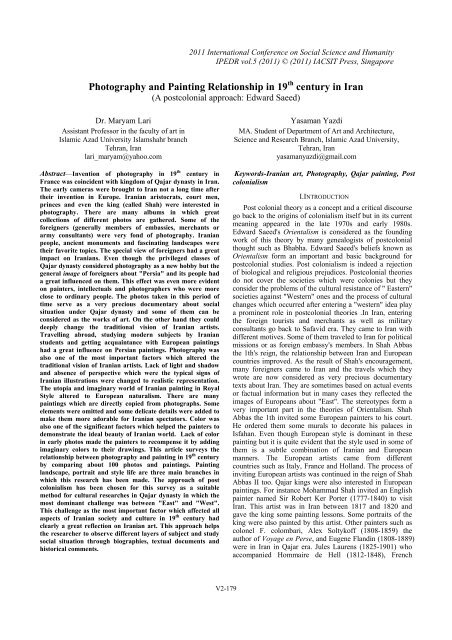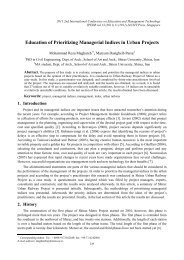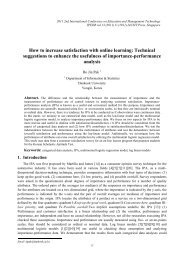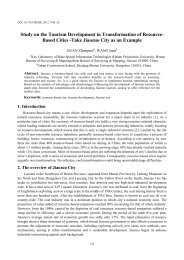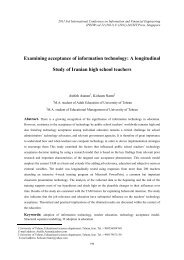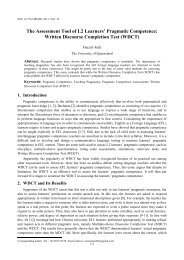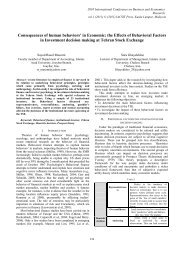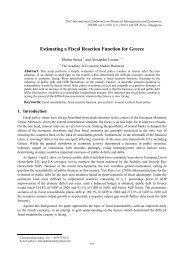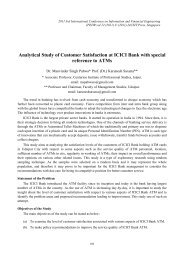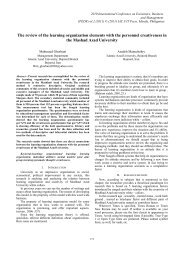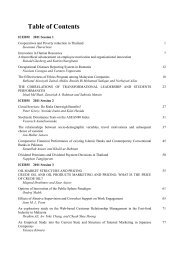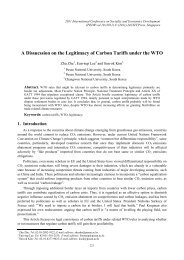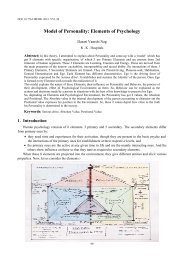Photography and Painting Relationship in 19th century in Iran - ipedr
Photography and Painting Relationship in 19th century in Iran - ipedr
Photography and Painting Relationship in 19th century in Iran - ipedr
You also want an ePaper? Increase the reach of your titles
YUMPU automatically turns print PDFs into web optimized ePapers that Google loves.
<strong>Photography</strong> <strong>and</strong> <strong>Pa<strong>in</strong>t<strong>in</strong>g</strong> <strong>Relationship</strong> <strong>in</strong> 19 th <strong>century</strong> <strong>in</strong> <strong>Iran</strong><br />
(A postcolonial approach: Edward Saeed)<br />
Dr. Maryam Lari<br />
Assistant Professor <strong>in</strong> the faculty of art <strong>in</strong><br />
Islamic Azad University Islamshahr branch<br />
Tehran, <strong>Iran</strong><br />
lari_maryam@yahoo.com<br />
Abstract—Invention of photography <strong>in</strong> 19 th <strong>century</strong> <strong>in</strong><br />
France was co<strong>in</strong>cident with k<strong>in</strong>gdom of Qajar dynasty <strong>in</strong> <strong>Iran</strong>.<br />
The early cameras were brought to <strong>Iran</strong> not a long time after<br />
their <strong>in</strong>vention <strong>in</strong> Europe. <strong>Iran</strong>ian aristocrats, court men,<br />
pr<strong>in</strong>ces <strong>and</strong> even the k<strong>in</strong>g (called Shah) were <strong>in</strong>terested <strong>in</strong><br />
photography. There are many albums <strong>in</strong> which great<br />
collections of different photos are gathered. Some of the<br />
foreigners (generally members of embassies, merchants or<br />
army consultants) were very fond of photography. <strong>Iran</strong>ian<br />
people, ancient monuments <strong>and</strong> fasc<strong>in</strong>at<strong>in</strong>g l<strong>and</strong>scapes were<br />
their favorite topics. The special view of foreigners had a great<br />
impact on <strong>Iran</strong>ians. Even though the privileged classes of<br />
Qajar dynasty considered photography as a new hobby but the<br />
general image of foreigners about "Persia" <strong>and</strong> its people had<br />
a great <strong>in</strong>fluenced on them. This effect was even more evident<br />
on pa<strong>in</strong>ters, <strong>in</strong>tellectuals <strong>and</strong> photographers who were more<br />
close to ord<strong>in</strong>ary people. The photos taken <strong>in</strong> this period of<br />
time serve as a very precious documentary about social<br />
situation under Qajar dynasty <strong>and</strong> some of them can be<br />
considered as the works of art. On the other h<strong>and</strong> they could<br />
deeply change the traditional vision of <strong>Iran</strong>ian artists.<br />
Travell<strong>in</strong>g abroad, study<strong>in</strong>g modern subjects by <strong>Iran</strong>ian<br />
students <strong>and</strong> gett<strong>in</strong>g acqua<strong>in</strong>tance with European pa<strong>in</strong>t<strong>in</strong>gs<br />
had a great <strong>in</strong>fluence on Persian pa<strong>in</strong>t<strong>in</strong>gs. <strong>Photography</strong> was<br />
also one of the most important factors which altered the<br />
traditional vision of <strong>Iran</strong>ian artists. Lack of light <strong>and</strong> shadow<br />
<strong>and</strong> absence of perspective which were the typical signs of<br />
<strong>Iran</strong>ian illustrations were changed to realistic representation.<br />
The utopia <strong>and</strong> imag<strong>in</strong>ary world of <strong>Iran</strong>ian pa<strong>in</strong>t<strong>in</strong>g <strong>in</strong> Royal<br />
Style altered to European naturalism. There are many<br />
pa<strong>in</strong>t<strong>in</strong>gs which are directly copied from photographs. Some<br />
elements were omitted <strong>and</strong> some delicate details were added to<br />
make them more adorable for <strong>Iran</strong>ian spectators. Color was<br />
also one of the significant factors which helped the pa<strong>in</strong>ters to<br />
demonstrate the ideal beauty of <strong>Iran</strong>ian world. Lack of color<br />
<strong>in</strong> early photos made the pa<strong>in</strong>ters to recompense it by add<strong>in</strong>g<br />
imag<strong>in</strong>ary colors to their draw<strong>in</strong>gs. This article surveys the<br />
relationship between photography <strong>and</strong> pa<strong>in</strong>t<strong>in</strong>g <strong>in</strong> 19 th <strong>century</strong><br />
by compar<strong>in</strong>g about 100 photos <strong>and</strong> pa<strong>in</strong>t<strong>in</strong>gs. <strong>Pa<strong>in</strong>t<strong>in</strong>g</strong><br />
l<strong>and</strong>scape, portrait <strong>and</strong> style life are three ma<strong>in</strong> branches <strong>in</strong><br />
which this research has been made. The approach of post<br />
colonialism has been chosen for this survey as a suitable<br />
method for cultural researches <strong>in</strong> Qajar dynasty <strong>in</strong> which the<br />
most dom<strong>in</strong>ant challenge was between "East" <strong>and</strong> "West".<br />
This challenge as the most important factor which affected all<br />
aspects of <strong>Iran</strong>ian society <strong>and</strong> culture <strong>in</strong> 19 th <strong>century</strong> had<br />
clearly a great reflection on <strong>Iran</strong>ian art. This approach helps<br />
the researcher to observe different layers of subject <strong>and</strong> study<br />
social situation through biographies, textual documents <strong>and</strong><br />
historical comments.<br />
2011 International Conference on Social Science <strong>and</strong> Humanity<br />
IPEDR vol.5 (2011) © (2011) IACSIT Press, S<strong>in</strong>gapore<br />
V2-179<br />
Yasaman Yazdi<br />
MA. Student of Department of Art <strong>and</strong> Architecture,<br />
Science <strong>and</strong> Research Branch, Islamic Azad University,<br />
Tehran, <strong>Iran</strong><br />
yasamanyazdi@gmail.com<br />
Keywords-<strong>Iran</strong>ian art, <strong>Photography</strong>, Qajar pa<strong>in</strong>t<strong>in</strong>g, Post<br />
colonialism<br />
I.INTRODUCTION<br />
Post colonial theory as a concept <strong>and</strong> a critical discourse<br />
go back to the orig<strong>in</strong>s of colonialism itself but <strong>in</strong> its current<br />
mean<strong>in</strong>g appeared <strong>in</strong> the late 1970s <strong>and</strong> early 1980s.<br />
Edward Saeed's Orientalism is considered as the found<strong>in</strong>g<br />
work of this theory by many genealogists of postcolonial<br />
thought such as Bhabha. Edward Saeed's beliefs known as<br />
Orientalism form an important <strong>and</strong> basic background for<br />
postcolonial studies. Post colonialism is <strong>in</strong>deed a rejection<br />
of biological <strong>and</strong> religious prejudices. Postcolonial theories<br />
do not cover the societies which were colonies but they<br />
consider the problems of the cultural resistance of " Eastern"<br />
societies aga<strong>in</strong>st "Western" ones <strong>and</strong> the process of cultural<br />
changes which occurred after enter<strong>in</strong>g a "western" idea play<br />
a prom<strong>in</strong>ent role <strong>in</strong> postcolonial theories .In <strong>Iran</strong>, enter<strong>in</strong>g<br />
the foreign tourists <strong>and</strong> merchants as well as military<br />
consultants go back to Safavid era. They came to <strong>Iran</strong> with<br />
different motives. Some of them traveled to <strong>Iran</strong> for political<br />
missions or as foreign embassy's members. In Shah Abbas<br />
the 1th's reign, the relationship between <strong>Iran</strong> <strong>and</strong> European<br />
countries improved. As the result of Shah's encouragement,<br />
many foreigners came to <strong>Iran</strong> <strong>and</strong> the travels which they<br />
wrote are now considered as very precious documentary<br />
texts about <strong>Iran</strong>. They are sometimes based on actual events<br />
or factual <strong>in</strong>formation but <strong>in</strong> many cases they reflected the<br />
images of Europeans about "East". The stereotypes form a<br />
very important part <strong>in</strong> the theories of Orientalism. Shah<br />
Abbas the 1th <strong>in</strong>vited some European pa<strong>in</strong>ters to his court.<br />
He ordered them some murals to decorate his palaces <strong>in</strong><br />
Isfahan. Even though European style is dom<strong>in</strong>ant <strong>in</strong> these<br />
pa<strong>in</strong>t<strong>in</strong>g but it is quite evident that the style used <strong>in</strong> some of<br />
them is a subtle comb<strong>in</strong>ation of <strong>Iran</strong>ian <strong>and</strong> European<br />
manners. The European artists came from different<br />
countries such as Italy, France <strong>and</strong> Holl<strong>and</strong>. The process of<br />
<strong>in</strong>vit<strong>in</strong>g European artists was cont<strong>in</strong>ued <strong>in</strong> the reign of Shah<br />
Abbas II too. Qajar k<strong>in</strong>gs were also <strong>in</strong>terested <strong>in</strong> European<br />
pa<strong>in</strong>t<strong>in</strong>gs. For <strong>in</strong>stance Mohammad Shah <strong>in</strong>vited an English<br />
pa<strong>in</strong>ter named Sir Robert Ker Porter (1777-1840) to visit<br />
<strong>Iran</strong>. This artist was <strong>in</strong> <strong>Iran</strong> between 1817 <strong>and</strong> 1820 <strong>and</strong><br />
gave the k<strong>in</strong>g some pa<strong>in</strong>t<strong>in</strong>g lessons. Some portraits of the<br />
k<strong>in</strong>g were also pa<strong>in</strong>ted by this artist. Other pa<strong>in</strong>ters such as<br />
colonel F. colombari, Alex Soltykoff (1808-1859) the<br />
author of Voyage en Perse, <strong>and</strong> Eugene Fl<strong>and</strong><strong>in</strong> (1808-1889)<br />
were <strong>in</strong> <strong>Iran</strong> <strong>in</strong> Qajar era. Jules Laurens (1825-1901) who<br />
accompanied Hommaire de Hell (1812-1848), French
archeologist <strong>in</strong> his mission <strong>in</strong> <strong>Iran</strong>, accepted some orders<br />
from k<strong>in</strong>g <strong>and</strong> court men.<br />
Fig1. A photo of Shams-ol-Emareh build<strong>in</strong>g<br />
Fig2. A pa<strong>in</strong>t<strong>in</strong>g of Shams-ol-Emareh, Mahmud Khan<br />
In general foreign artists were warmly welcomed <strong>in</strong><br />
aristocratic societies of Qajar period. Some Russian artists<br />
came to <strong>Iran</strong> to pa<strong>in</strong>t k<strong>in</strong>g's portraits which were mentioned<br />
<strong>in</strong> the travel of Jacob Eduard Polak (1818-1891) who was<br />
the physician of Qajar court. Presence of foreign pa<strong>in</strong>ter <strong>in</strong><br />
<strong>Iran</strong> was one of the most <strong>in</strong>fluential reasons of fundamental<br />
changes <strong>in</strong> traditional pa<strong>in</strong>t<strong>in</strong>g. Departure of <strong>Iran</strong>ian<br />
students to European countries to study modern courses was<br />
also very important which caused great alterations <strong>in</strong><br />
traditional vision about the function <strong>and</strong> production of<br />
artistic works. Send<strong>in</strong>g <strong>Iran</strong>ian students abroad which was<br />
started <strong>in</strong> Safavid period was cont<strong>in</strong>ued <strong>in</strong> Qajar era. The<br />
<strong>in</strong>fluence of European pa<strong>in</strong>t<strong>in</strong>g on <strong>Iran</strong>ian artists is quite<br />
obvious <strong>in</strong> the works which were gathered <strong>in</strong> the albums of<br />
National Library <strong>in</strong> Paris. Some copies of Albert Durer's<br />
pa<strong>in</strong>t<strong>in</strong>gs made by <strong>Iran</strong>ian artists are saved <strong>in</strong> these albums.<br />
Apart from Mohammad Kazem <strong>and</strong> Haji Baba Afshar who<br />
were sent to Engl<strong>and</strong> by Abbas Mirza (the crown pr<strong>in</strong>ce),<br />
many other students left <strong>Iran</strong> to learn methods of pa<strong>in</strong>t<strong>in</strong>g<br />
V2-180<br />
Fig3. A photo of Badgir build<strong>in</strong>g<br />
Fig4.A pa<strong>in</strong>t<strong>in</strong>g of Badgir build<strong>in</strong>g, Mahmud Khan<br />
among them sani-ol-Molk <strong>and</strong> Mozan-ol-Molk are the<br />
most celebrated ones. It is generally obvious that Farangi<br />
Sazi (European Style) which was <strong>in</strong>itiated <strong>in</strong> Safavid period<br />
(18 <strong>century</strong>) grew <strong>in</strong> Qajar era (19 <strong>century</strong>) <strong>and</strong> f<strong>in</strong>ally<br />
resulted to European Naturalism. Not only the style <strong>and</strong><br />
mediums of traditional pa<strong>in</strong>t<strong>in</strong>g but also the subjects <strong>and</strong><br />
context were completely altered.<br />
II -GENERAL CHARACTERISTICS OF IRANIAN<br />
PAINTING<br />
One of the most typical manners <strong>in</strong> <strong>Iran</strong>ian pa<strong>in</strong>t<strong>in</strong>g was<br />
the family relationship. Crafts <strong>and</strong> artistic methods were<br />
firstly taught by father to his elder son or nephews <strong>and</strong> them<br />
to the other pupils of the workshop. Many families who<br />
were traditionally famous for a special craft tried to keep the<br />
secrets of their job <strong>in</strong>side the family. Ghafari, Vesal <strong>and</strong><br />
Esfahani are some of these renowned families. Group<br />
work<strong>in</strong>g was another typical manner <strong>in</strong> traditional ateliers.<br />
The master used to draw the ma<strong>in</strong> l<strong>in</strong>es <strong>and</strong> the pupils used<br />
to add color the background <strong>and</strong> unimportant spaces.<br />
Delicate <strong>and</strong> significant parts of pa<strong>in</strong>t<strong>in</strong>g were done by the<br />
master himself. For <strong>in</strong>stance <strong>in</strong> the process of illustrat<strong>in</strong>g the<br />
book called 1001 nights, Sani-ol-Molk pa<strong>in</strong>ted the face of<br />
the characters <strong>and</strong> the clothes but the backgrounds were<br />
done by the pupils. Copy mak<strong>in</strong>g was also very common <strong>in</strong><br />
Qajar ear. Historical Scenes, portraits of the k<strong>in</strong>gs <strong>and</strong> some<br />
favorite illustrations were repeatedly copied to decorate
palaces <strong>and</strong> mansions <strong>in</strong> different cities. After f<strong>in</strong>ish<strong>in</strong>g an<br />
illustration, if was not common for the artists to sign their<br />
work. The ma<strong>in</strong> reason was that the pa<strong>in</strong>t<strong>in</strong>g was done by a<br />
group of artists not an <strong>in</strong>dividual so modesty was not the<br />
ma<strong>in</strong> reason that many of traditional works were without a<br />
specific signature. Stylization was another trait of <strong>Iran</strong>ian<br />
pa<strong>in</strong>t<strong>in</strong>g. The pa<strong>in</strong>ters tried to recognize the ma<strong>in</strong> features of<br />
nature <strong>and</strong> demonstrate them with some established ways.<br />
This method of vision was somehow apposite to the<br />
naturalism. Simplify<strong>in</strong>g <strong>and</strong> Repeat<strong>in</strong>g were used <strong>and</strong><br />
symmetrical compositions helped the artists to demonstrate<br />
the utopian <strong>and</strong> visionary scenes. The traditional artists used<br />
to change the normal scales of nature. They exaggerated the<br />
reality to display an unreal <strong>and</strong> imag<strong>in</strong>ary world. Traditional<br />
pa<strong>in</strong>t<strong>in</strong>g was very decorative. The pa<strong>in</strong>ters used various<br />
motifs <strong>and</strong> comb<strong>in</strong>e them with each other to create new ones.<br />
Blank spaces were all covered with decorative elements.<br />
The artists spent long hours to f<strong>in</strong>ish a piece of work. This is<br />
one of the most characteristics of <strong>Iran</strong>ian art which can be<br />
seen <strong>in</strong> h<strong>and</strong>icrafts, architecture … etc. Professor Pope<br />
applies this attitude to the patience of <strong>Iran</strong>ian people. He<br />
noticed some elements of abstraction <strong>in</strong> Persian art which<br />
was very much emotional <strong>and</strong> on the other h<strong>and</strong> was related<br />
to religious <strong>and</strong> mythical believes.<br />
Fig5.A photo Saltanat Abad Palace.<br />
Fig6. Saltanat Abad Palace, Kamal-ol-Molk, oil on canvas<br />
V2-181<br />
III -PHOTOGRAPHY IN IRAN<br />
<strong>Photography</strong> was <strong>in</strong>troduced to <strong>Iran</strong>ian society by a<br />
French man called Jules Richard (f.1) between 1844 <strong>and</strong><br />
1846 which was only 3 years after its <strong>in</strong>vention <strong>in</strong> Europe.<br />
<strong>Iran</strong>ian aristocrats, court men <strong>and</strong> even the k<strong>in</strong>g became<br />
<strong>in</strong>terested <strong>in</strong> this new media. Naser Mirza , the 13 years<br />
crown pr<strong>in</strong>ce, was very fond of tak<strong>in</strong>g photos. He gathered<br />
his photos <strong>in</strong> some albums. Harm's women, beautiful<br />
palaces <strong>and</strong> court people were his favorite topics. He used to<br />
add some texts to his photos which serve us as a very<br />
precious documentary for recogniz<strong>in</strong>g the character of the<br />
photos. Some of the young students of Dar- ol- Fonon (The<br />
modern school of Qajar era) who belonged to the highest<br />
social class were sent to Europe to learn more about<br />
photography. K<strong>in</strong>g ordered to establish a well equipped<br />
workshop for photography. Apart from aristocrats, the<br />
Armenians were very active <strong>in</strong> the field. Many photos were<br />
taken by foreigners such as military consultants or<br />
physicists who stayed <strong>in</strong> <strong>Iran</strong>. A. Kriziz (Austrian) <strong>and</strong> L.<br />
pesce (Italian) were officers who took many photographs of<br />
<strong>Iran</strong>ian l<strong>and</strong>scapes. The photos taken by focchetti (Italian<br />
officer) had considerable <strong>in</strong>fluence over <strong>Iran</strong>ians. A French<br />
photographer named Carllione was very <strong>in</strong>fluential not only<br />
as an <strong>in</strong>structor but also as a seller of chemical substances<br />
<strong>and</strong> <strong>in</strong>struments related to photography.<br />
IV - PHOTOGRAPHY AND IRANIAN PAINTING<br />
There are three ma<strong>in</strong> styles <strong>in</strong> Qajar pa<strong>in</strong>t<strong>in</strong>g. The first<br />
one called Court Style. The artists <strong>in</strong> early years of Qajar<br />
dynasty followed the traditional methods <strong>and</strong> vision which<br />
were typical <strong>in</strong> Afshar <strong>and</strong> Z<strong>and</strong> periods. The compositions<br />
<strong>in</strong> Court style are symmetrical <strong>and</strong> still to demonstrate the<br />
idealistic <strong>and</strong> glorious world of court life. There are so many<br />
decorative motifs which cover all the surfaces. As the result<br />
of enter<strong>in</strong>g European elements <strong>in</strong>to <strong>Iran</strong>ian art, the pa<strong>in</strong>ters<br />
made some efforts to show perspective but <strong>in</strong> general the<br />
pa<strong>in</strong>t<strong>in</strong>g are timeless <strong>and</strong> belong to nowhere. Court Style<br />
was slightly <strong>in</strong>fluenced by photography. Although this<br />
manner was affected by European pa<strong>in</strong>t<strong>in</strong>g which was very<br />
fashionable <strong>in</strong> Qajar era but it was mostly loyal to<br />
traditional pa<strong>in</strong>t<strong>in</strong>g. Court Style as a mascul<strong>in</strong>e, patrician<br />
<strong>and</strong> imag<strong>in</strong>ary manner was <strong>in</strong> complete contrast with<br />
photography as a realistic media. The style life pa<strong>in</strong>ted by<br />
Mirza Baba has the usual features of the Court Style. Even<br />
though there are some dist<strong>in</strong>guish<strong>in</strong>g qualities which shows<br />
the <strong>in</strong>fluence of European pa<strong>in</strong>t<strong>in</strong>g such as imperfect use of<br />
perspective, but the pa<strong>in</strong>ter has rema<strong>in</strong>ed loyal to the ma<strong>in</strong><br />
pr<strong>in</strong>ciples of conventional view. The Court Style was altered<br />
by some factors like photography <strong>and</strong> changed <strong>in</strong>to one of<br />
the most impressive manners <strong>in</strong> Qajar pa<strong>in</strong>t<strong>in</strong>g: The passage<br />
style.<br />
V -PHOTOGRAPHY AND PASSAGE STYLE<br />
Passage Style is a manner <strong>in</strong> Qajar pa<strong>in</strong>t<strong>in</strong>g which lastly<br />
ended with complete surrender to Naturalism. This style was<br />
<strong>in</strong> total harmony with modern ideas such as democracy <strong>and</strong><br />
constitutionalism. Two <strong>Iran</strong>ian politicians played significant<br />
roles <strong>in</strong> the process of modernization <strong>in</strong> <strong>Iran</strong>. Amir Kabir
(The prime m<strong>in</strong>ister) <strong>and</strong> Abbas Mirza (The crown pr<strong>in</strong>ce)<br />
did their best to lead the <strong>Iran</strong>ian society to modernism.<br />
<strong>Iran</strong>ian <strong>in</strong>tellectuals <strong>and</strong> many <strong>in</strong>telligent <strong>and</strong> well educated<br />
court men tried to put their ideas <strong>in</strong>to action. A Comb<strong>in</strong>ation<br />
of various factors helped the process of modernization <strong>in</strong><br />
<strong>Iran</strong>. Translation movement, pr<strong>in</strong>t<strong>in</strong>g <strong>and</strong> publication<br />
<strong>in</strong>dustry, higher education system, send<strong>in</strong>g students abroad<br />
<strong>and</strong> photography were the most <strong>in</strong>fluential elements.<br />
Etemad-ol-Saltaneh, a dom<strong>in</strong>ant politcian <strong>in</strong> Qajar era,<br />
mentioned <strong>in</strong> his book that photography had an essential<br />
impact on pa<strong>in</strong>t<strong>in</strong>g. "<strong>Photography</strong> helped the <strong>Iran</strong>ian<br />
pa<strong>in</strong>ters to represent different themes. With the help of<br />
photography, the pa<strong>in</strong>ters succeeded <strong>in</strong> us<strong>in</strong>g perspective<br />
<strong>and</strong> light <strong>and</strong> shadow which made it easier for them to<br />
imitate the nature. It is even possible to claim that the<br />
photography is a k<strong>in</strong>d of pa<strong>in</strong>t<strong>in</strong>g" Some of the artists of<br />
Passage Style used photography as the first step to create<br />
their pa<strong>in</strong>t<strong>in</strong>gs. Among them Mahmud khan is one the most<br />
renowned one. He used to take numerous photos of<br />
build<strong>in</strong>gs which usually served him as a pictorial reference.<br />
Compar<strong>in</strong>g the photo of Shams-ol- Emareh (f.1) with the<br />
pa<strong>in</strong>t<strong>in</strong>g of this build<strong>in</strong>g (f.2), it is quite recognizable that<br />
Mahmud khan used the photography as the source at his<br />
work but he made many alterations. Mahmud khan<br />
elim<strong>in</strong>ated some of unnecessary elements <strong>and</strong> added some<br />
new details to make the pa<strong>in</strong>t<strong>in</strong>g more fasc<strong>in</strong>at<strong>in</strong>g. He<br />
changed the scales of the elements <strong>and</strong> made them bigger or<br />
smaller to create a better image. On the other h<strong>and</strong>, as the<br />
photography <strong>in</strong> that time was achromatic, he added some<br />
realistic or imag<strong>in</strong>ary colors to his works. Tak<strong>in</strong>g different<br />
photos from the same build<strong>in</strong>g enabled him to choose the<br />
best one. Manhood khan sometimes added the human<br />
figures to his images. In the pa<strong>in</strong>t<strong>in</strong>g called "the 15 th<br />
anniversary of Qajar dynasty", his photographic vision is<br />
obvious. The characters seated <strong>in</strong> two opposite l<strong>in</strong>es look at<br />
the spectator. Apart from pay<strong>in</strong>g attention to perspective,<br />
Mahmud khan made efforts to create some harmony<br />
between colors. He f<strong>in</strong>ally succeeded <strong>in</strong> chang<strong>in</strong>g the severe<br />
<strong>and</strong> rough photos of his time <strong>in</strong>to sensitive <strong>and</strong> poetic<br />
images. His ability to soften the spiritless photos of the<br />
build<strong>in</strong>g was due to his pa<strong>in</strong>t<strong>in</strong>g talent. It is useful to<br />
mention that as a professional poet, he was entitled as<br />
Malek-ol-Shoara (the master of poets). On the other h<strong>and</strong> he<br />
added some decorative motifs to his images which were not<br />
quite clear <strong>in</strong> the photos. As the result of putt<strong>in</strong>g more<br />
details, the pa<strong>in</strong>t<strong>in</strong>gs of Mahmud khan seem more complete<br />
than the photos. The technical problems of photography <strong>in</strong><br />
its early years caused difficulties <strong>in</strong> demonstrat<strong>in</strong>g the whole<br />
reality because some parts of the photos were completely<br />
faded out. As the conclusion, it is worth mention<strong>in</strong>g that the<br />
pa<strong>in</strong>ters of Passage Style took full advantage of<br />
photography but kept own specific way of visual<br />
expression.<br />
They succeeded <strong>in</strong> comb<strong>in</strong><strong>in</strong>g the naturalistic vision of<br />
photography with delicate <strong>and</strong> unrealistic elements of<br />
traditional <strong>Iran</strong>ian pa<strong>in</strong>t<strong>in</strong>g. On the other h<strong>and</strong>, the Passage<br />
Style pa<strong>in</strong>ters used photography as an auxiliary for<br />
demonstrat<strong>in</strong>g their own world <strong>and</strong> never surrender<br />
themselves to it. They tried to show the real life <strong>in</strong> Qajar era<br />
V2-182<br />
but they did not ab<strong>and</strong>on their ideas about an imag<strong>in</strong>ary<br />
world.<br />
Fig 7. A pa<strong>in</strong>t<strong>in</strong>g of Naser –ed-d<strong>in</strong> Shah, Sani-ol-molk<br />
Fig 8. A pa<strong>in</strong>t<strong>in</strong>g of Naser –ed-d<strong>in</strong> Shah, Kamal-ol-Molk<br />
Fig 9. Carpet Weavers, Moosa Momayezi, oil on canvas<br />
Fig 10.A photo of Carpet Weavers <strong>in</strong> Qajar period<br />
VI -PHOTOGRAPHY AND NATURALISM<br />
The efforts of the artists of Passage Style to ma<strong>in</strong>ta<strong>in</strong> the<br />
former st<strong>and</strong>ards of traditional pa<strong>in</strong>t<strong>in</strong>g were successful but<br />
the follow<strong>in</strong>g pa<strong>in</strong>ters did not cont<strong>in</strong>ue the way of their<br />
preced<strong>in</strong>g colleagues. It was generally due to the social<br />
situation <strong>in</strong> Qajar era which was mentioned before. Realistic<br />
<strong>and</strong> photographic vision became so dom<strong>in</strong>ant that it was<br />
considered a value for a pa<strong>in</strong>t<strong>in</strong>g to be similar to a photo.
Mohammad Ghafari (Kamal- ol- molk), the head of this new<br />
tendency, with the help of his followers <strong>and</strong> pupils<br />
dom<strong>in</strong>ated the ma<strong>in</strong> process of this style <strong>in</strong> <strong>Iran</strong>. They<br />
created their pa<strong>in</strong>t<strong>in</strong>gs by cop<strong>in</strong>g photos or imitat<strong>in</strong>g the<br />
nature. Kamal- ol- molk <strong>in</strong> his first cycle of his artistic<br />
creation, pa<strong>in</strong>ted l<strong>and</strong>scapes <strong>and</strong> people <strong>in</strong> such a way that<br />
models were taken from photos. In the pa<strong>in</strong>t<strong>in</strong>g of The<br />
Musicians fifteen characters posed <strong>in</strong> a photographic way.<br />
This pa<strong>in</strong>t<strong>in</strong>g belongs to the series which serve us as<br />
part anthropology of Qajar period. In some cases the<br />
naturalism exist<strong>in</strong>g <strong>in</strong> kamal-ol-molk's pa<strong>in</strong>t<strong>in</strong>gs was<br />
switched <strong>in</strong>to Realism. Many critics admired the Hall of<br />
Mirrors as the most brilliant pa<strong>in</strong>t<strong>in</strong>g <strong>in</strong> the first cycle of<br />
kamal-ol-molk's artistic life. The ma<strong>in</strong> character of this<br />
pa<strong>in</strong>t<strong>in</strong>g is Naser-al-D<strong>in</strong> Shah seated <strong>in</strong> the middle of a large<br />
hall <strong>in</strong> his palace.<br />
Photographic vision, subtle performance of details <strong>and</strong><br />
elaborate representation of decorative elements are the basic<br />
characteristics of this pa<strong>in</strong>t<strong>in</strong>g.Hassan Ali Vaziri wrote<br />
about the abilities of kamal-ol- Molk <strong>in</strong> photo-like<br />
representations: "when he was between 30 <strong>and</strong> 35 years old,<br />
he used to draw the portraits of <strong>Iran</strong>ian <strong>and</strong> foreign<br />
politicians for Sharaf newspaper which was monthly<br />
published. The portraits were so realistic that people<br />
mistook them for real People <strong>and</strong> greeted them. The<br />
mastership of this artist <strong>in</strong> pa<strong>in</strong>t<strong>in</strong>g photo- like details<br />
entitled him Kamal-ol-Molk (the perfect one)".<br />
The comparison of a photo of the palace (f.5) with a<br />
pa<strong>in</strong>t<strong>in</strong>g with the same subject (f.6) shows the <strong>in</strong>fluence of<br />
photography on his works. It is essential to mention that<br />
although the artists of Passage Style were a great deal<br />
<strong>in</strong>fluenced by Naturalism but they kept some elements of<br />
tradition <strong>in</strong> their works someth<strong>in</strong>g that never happened to<br />
Naturalists: They completely accepted the photographic<br />
vision. This fact becomes more evident by compar<strong>in</strong>g the<br />
portraits of the k<strong>in</strong>g <strong>in</strong> both styles (f.7&8).<br />
The f<strong>in</strong>al change to Naturalism occurred more powerful<br />
<strong>in</strong> the works of the follow<strong>in</strong>g artist. Mousa Momayezi was<br />
one of the pa<strong>in</strong>ters whose works are typical. He used to<br />
choose anthropological subjects such as carpet wearers (f.9)<br />
which were are of the favorite topics of the time.A triple<br />
relationship among pa<strong>in</strong>t<strong>in</strong>g, photography <strong>and</strong> lithography<br />
happened <strong>in</strong> the last years of Qajar era. The draw<strong>in</strong>gs<br />
directly copied from photos were published <strong>in</strong> Sharaf <strong>and</strong><br />
Sherafat, two ma<strong>in</strong> newspapers of the time. The newspapers<br />
published with the technique of lithography conta<strong>in</strong>ed<br />
mostly the draw<strong>in</strong>gs of <strong>Iran</strong>ian l<strong>and</strong>scapes <strong>and</strong> politicians.<br />
This relationship was sometimes manifested <strong>in</strong> the<br />
illustrations of the books.<br />
VII- CONCLUSION<br />
The characteristics of traditional pa<strong>in</strong>t<strong>in</strong>g which were<br />
tendency to decoration, imag<strong>in</strong>ary representation <strong>and</strong><br />
idealistic expression changed to naturalistic performance <strong>in</strong><br />
Qajar era. The factors among them photography, as are the<br />
most <strong>in</strong>fluential ones, played a significant role <strong>in</strong> this<br />
alteration. The artists of Passage Style took advantage of<br />
photography to improve their abilities of representation but<br />
V2-183<br />
they never surrendered to Naturalism. They succeeded <strong>in</strong><br />
creat<strong>in</strong>g a compound style which possessed both the <strong>Iran</strong>ian<br />
<strong>and</strong> European features. Many critics consider photography<br />
as the most important cha<strong>in</strong> connect<strong>in</strong>g tradition to<br />
modernism <strong>in</strong> <strong>Iran</strong>ian art which became stronger dur<strong>in</strong>g<br />
Qajar period. The alterations which had started <strong>in</strong> Safavid<br />
era cont<strong>in</strong>ued <strong>in</strong> Afshar <strong>and</strong> Z<strong>and</strong> periods <strong>and</strong> reached<br />
f<strong>in</strong>ally to its summit by the end of Qajar dynasty.It is worth<br />
mention<strong>in</strong>g that European photographers <strong>in</strong> the early years<br />
of <strong>in</strong>vention of photography tried to imitate the pr<strong>in</strong>ciples of<br />
pa<strong>in</strong>t<strong>in</strong>g. They used to choose the common compositions<br />
<strong>and</strong> even copied the light <strong>and</strong> shadow exist<strong>in</strong>g <strong>in</strong> pa<strong>in</strong>t<strong>in</strong>gs.<br />
By us<strong>in</strong>g pectoral element of European pa<strong>in</strong>t<strong>in</strong>gs, the<br />
photographers endeavored to present this new visual media<br />
as an artistic medium which was a very challeng<strong>in</strong>g topic <strong>in</strong><br />
those years. After some years photographers succeeded <strong>in</strong><br />
fix<strong>in</strong>g photography as an <strong>in</strong>dependent means of expression.<br />
In <strong>Iran</strong> the story was quite different. The <strong>Iran</strong>ian pa<strong>in</strong>t<strong>in</strong>g<br />
<strong>in</strong>fluenced by photography lost its previous values. The<br />
realistic representation exist<strong>in</strong>g <strong>in</strong> this media led the <strong>Iran</strong>ian<br />
pa<strong>in</strong>t<strong>in</strong>g to absolute Naturalism. The dom<strong>in</strong>ant challenge<br />
between Modernism <strong>and</strong> Tradition <strong>in</strong> <strong>Iran</strong>ian art rema<strong>in</strong>ed<br />
the most critical topic for discussion which survived up to<br />
present time.<br />
REFERENCES<br />
[1] Diba, Layla, Royal Persian <strong>Pa<strong>in</strong>t<strong>in</strong>g</strong>, New Tork: I.B. Tauris Pub,<br />
1990.<br />
[2] Diba, Layla, “Yahya Ghaffari”, Persian pa<strong>in</strong>t<strong>in</strong>g, London: I.B.Pub,<br />
2000.<br />
[3] Falk. S. j, Qajar <strong>Pa<strong>in</strong>t<strong>in</strong>g</strong>s, London: Faber <strong>and</strong> Faber Ltd, 1972.<br />
[4] Hillenbr<strong>and</strong>, Robert, Persian <strong>Pa<strong>in</strong>t<strong>in</strong>g</strong>, London: I.B. Tauris Pub, 2000.<br />
[5] Khalili, Nasser, Laquer of the Islamic L<strong>and</strong>s, New York: Nour Pub,<br />
1997.<br />
[6] Leath, John, Pe<strong>in</strong>ture Qajar, Tehran: 1993.<br />
[7] Loukon<strong>in</strong>e, Vladimir, Lost Treasures of Persia, Engl<strong>and</strong>: Mage Pub,<br />
1996.<br />
[8] Loukon<strong>in</strong>e, Vladimir, L’Art Persan, Mage Pub, Engl<strong>and</strong>:Mage Pub,<br />
1995.<br />
[9] Najmabadi, Afsaneh, Women with mustaches <strong>and</strong> men without beard,<br />
London: University Of California Press, 2005.<br />
[10] Parviz, Nazan<strong>in</strong>, Tehran, Z<strong>and</strong> Pub. Tehran: Z<strong>and</strong> Pub, 2000.<br />
[11] Qajar Portraits, Ernest & young, Georgia: Ernest & young, 2004.<br />
[12] Raby, Julian, Qajar Portraits, London: Azimuth Pub, 1999.<br />
[13] Rob<strong>in</strong>son, B.W, Persian <strong>Pa<strong>in</strong>t<strong>in</strong>g</strong>s, London: Philip Wilson Pub, 1976.<br />
[14] Scare, Jenifer, Domestic Culture <strong>in</strong> the Middle East, Scotl<strong>and</strong>: N.M.S,<br />
1996.<br />
[15] Smith, Murdoch, Persian Art, 1876.<br />
[16] Soudavar, Abolala, Art of the Persian Courts, New York: Rizzoli,<br />
1992.<br />
[17] Surien, Robert, Sarve naz, Genève: Nagel, 1967.<br />
[18] The Splendor of <strong>Iran</strong>, Volume 3, London: E. Booth- Clibborn, 2001.<br />
[19] Turner, Jane, the Dictionary of Art, Vol. 29, New York: Macmillan,<br />
1999.<br />
[20] Veroit, Stephen, Occidentalism, New York: Nour, 1997.<br />
[21] Welch, Antony, Artists of the Shah, Engl<strong>and</strong>: Yale University, 1976.<br />
[22] Zoka, Yahya, The Italian Embassy <strong>in</strong> Tehran, Padova:Grafimex<br />
Pub,1999.


